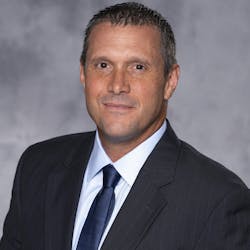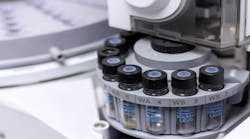The unusually quick development, approval and delivery of COVID-19 vaccines marked an inflection point for the life sciences and pharmaceutical industries. Nathan Pettus, president of Emerson’s systems and software business, describes it as an accomplishment of humankind like almost nothing he’s seen in his lifetime.
Nathan Pettus, president of Emerson’s systems and software business
Considering that Emerson software and technologies played a role in developing three of the four vaccines manufactured in the Western world, it has been an especially exciting time for the company. Pharma Manufacturing recently spoke with Pettus about trends and technologies enabling the industry to become more flexible, modular and agile.
Q: What are some of the roadblocks to improving time to market for new therapies?
A: Time to market is not a new challenge for life sciences companies, but what is becoming increasingly challenging for them is the dynamic nature of their pipelines and how drug recipes are becoming more specific for personalized medicine. Having details lost in translation due to unsatisfactory technology transfer is the primary roadblock.
First, you have the language of the chemist and biologist — the scientists who conceive, scale and understand the recipe for the drug, whether it’s a product, substance, or even a biologic. Then you have the language of manufacturing and automation used by the facilities that make the drug.
The translation between those two languages is what we call technology transfer, so it’s transferring the process, workflows and recipes that the scientists understand into the automation language of manufacturing operational technology (OT) facilities that make the drugs using the equipment in place.
Although translations have always been a major challenge, it used to come up maybe once every ten years or so because manufacturers would typically have a single facility making one type of drug, or a family of very similar drugs, for many years or even decades. Now, technology transfers are occurring once or twice every year or two in much smaller, dedicated, modular facilities.
Accelerating the time to market by expediting technology transfers is needed more now than it has ever been, due to the variety of new drugs being made and how life sciences facilities are becoming much more flexible, agile and modular and require more frequent changeovers.
The COVID vaccines are seen by many as the hallmark of this effort. Part of their success was the shortened approval process, but there was also a tremendous amount of effort to complete the technology transfer much more quickly in order to produce the vaccines faster.
Q: What are some of the things being done to facilitate this new, flexible manufacturing strategy?
A: I would say the main underlying initiative that most drug manufacturers and biologics companies are undertaking is trying to digitalize the drug development process as much as they can. Doing so with the vaccines proved a great success.
It is very difficult to shrink the timeline when the translation of scientific language to the manufacturing automation system’s language is done manually. While automation system processes have been digitalized for years, recipe generation processes have historically been — and are largely still — paper-based. This is likely to change with 21 CFR Part 11’s allowance for electronically signed documents.
If you can digitalize the process developed to make the drug, including its recipes, workflows and scaling instructions, then you have a chance to automate the technology transfer to be almost one click. Then, in turn, you can quickly feed back to the digitalized recipes any opportunities found in the plant to improve the process.
This has never been done before but we have a chance at it now because Fluxa, a strategic technology partner of ours, has technology that digitalizes the language of scientists. Combining that with Emerson’s digital process automation solutions is very powerful.
Other enablers of flexible, modular manufacturing are found in industry standards. For instance, Open Platform Communications (OPC) process control standards allow different pieces of equipment to talk to each other without having to go through a lot of integration. And a new standard framework called Module Type Package (MTP) is specifically built to allow pieces of equipment on skids to be moved around, reconnected, and integrated into the automation system without much effort during what we call the ‘ballroom dance’ of facility reconfigurations.
Another strategy teams are using to shrink the product timeline is to bring more analysis in line with the process. Innovators are embracing new technology to bring process analytical technology (PAT) into the control loop to make quality testing part of the process. Using PAT embedded in the control system, operations can perform quality attribute calculations in real time and eliminate the time spent waiting for testing after production is complete. This strategy not only brings products more quickly to market, but also provides more opportunities to save batches during production, leading to less waste.
Q: What are you seeing in terms of trends in the information systems world relative to pharma manufacturing?
A: Data is the new gold. There is so much information involved in making a drug that from an information systems perspective, data is becoming incredibly important. Additionally, in the life sciences industry, the FDA requires that all processes be validated, and all data used be kept in records that are auditable and quality assured.
The key right now for a lot of our customers is making sure they understand how to collect, manage and contextualize their data to digitalize the overall process and release their products to market in as automated a way as possible — but still do it under this validated environment that is regulated by the government because lives are at stake.
Emerson uses what we call a data lake to help our customers aggregate that information. It is capable of having all kinds of disparate types of information collected across the development of the drug, such as lab data, lab reports, people reports, barcode scans, temperatures and pressures while the drug was made, and the timing of production. All of that kind of information is pulled together and then, more importantly, contextualized in an electronic batch record of the drug, so you know it is from that batch, made at that facility during that period of time and is now over there in that container ready to be shipped and released to the public.
Q: Are these trends only relevant to greenfield projects, or are organizations repurposing equipment to accomplish the same thing?
A: Actually, the industry is forcing all of us to remodel both new and old facilities. You would think a greenfield project would be easy to design for the modular and agile trends, being that it is built from scratch, but the issue is you don’t really know how you are going to use that facility in two years. Leveraging existing equipment in a new way in a brownfield facility, built decades ago, is even harder.
Consequently, we have to design differently than we ever have before. The entire industry is trying to figure out how to make any equipment as flexible and configurable as possible. It goes back to making sure you have a process that is digitalized, data that is contextualized, and the ability to automatically connect or reconnect equipment to the facility’s manufacturing process control and safety systems using solutions like the DeltaV Distributed Control System (DCS) and DeltaV Electronic Marshalling from Emerson. And this goes all the way down to the individual movable tank and even single-use equipment.
Q: What strategies and technologies are plants and their regulatory groups using to ensure they are running optimally and that everything is working the way it should?
A: Some concepts I talked about earlier are crucial in this regard. On the regulatory front, the ability to digitalize recipe processes that were for many years paper-based while still meeting the requirements around validation is a big trend. On the plant floor, a huge trend is using solutions like Emerson’s DeltaV with the MTP framework to streamline interoperability and ensure the control system and control logic for the plant can handle automatic reconfigurations.
The other trend I would add is how the industry is recognizing that software is really key to making this new world work. That’s very different than what we would have said 10-15 years ago. Today’s software enables the necessary flexibility and agility from the plant floor all the way up to the supply chain and to the executives running the business, while helping to keep everything validated for the regulatory groups.

